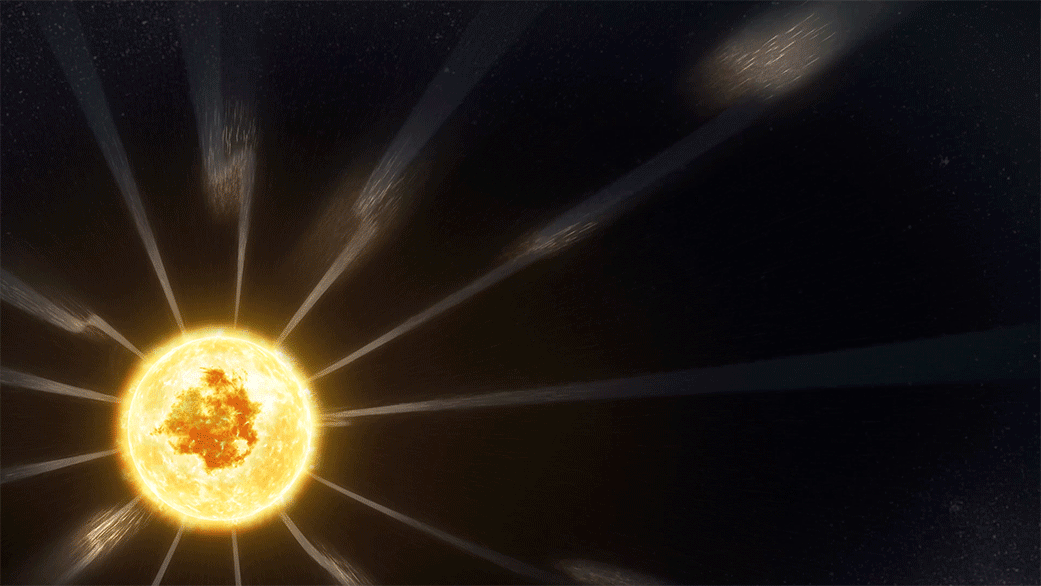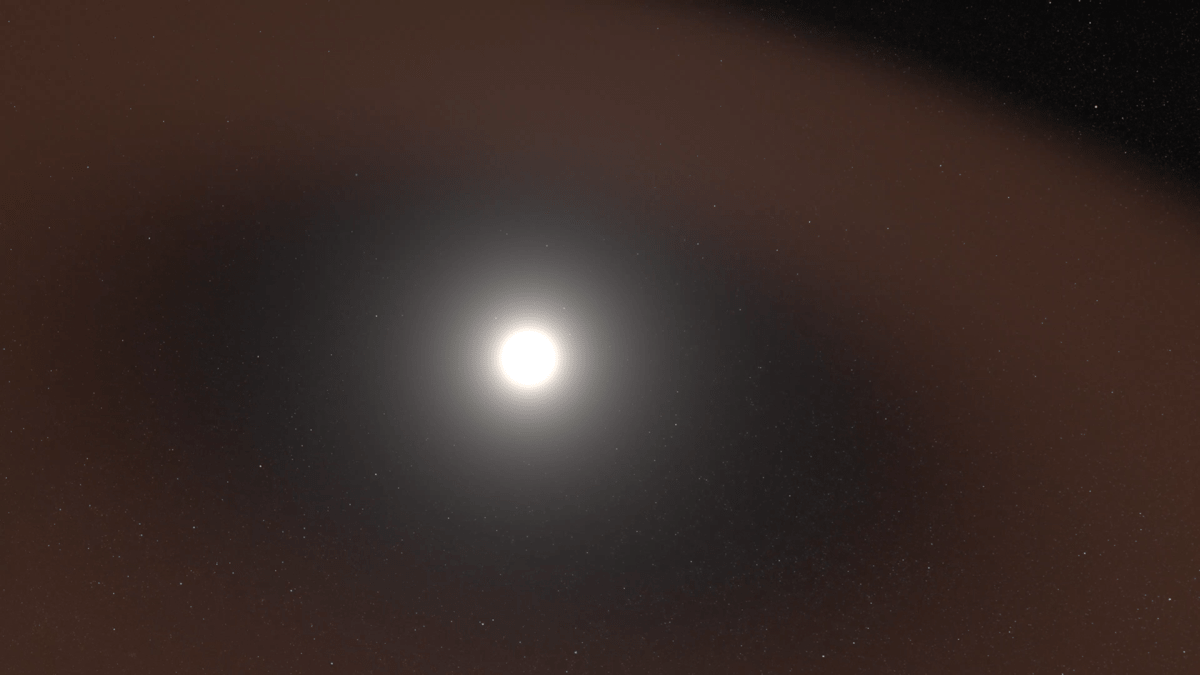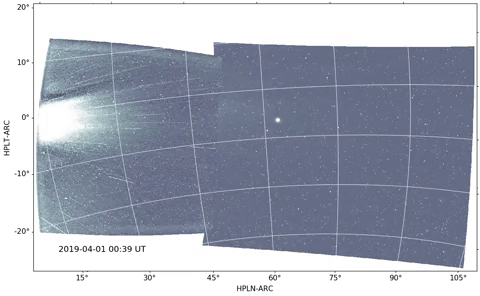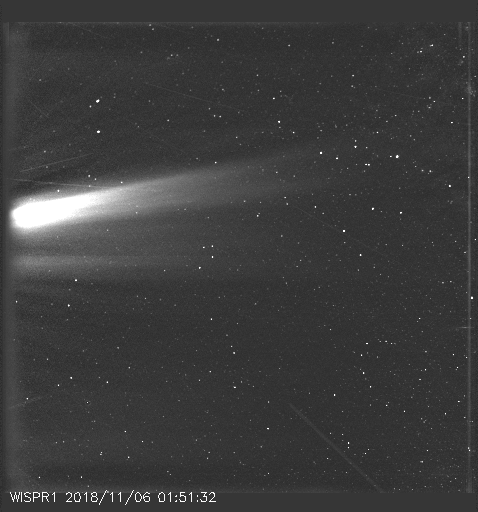The Parker Solar Probe Gives Us A New Glimpse Of The Sun
17:24 minutes

In August 2018, NASA sent the Parker Solar Probe off on its anticipated seven-year-long mission to study the sun. Already, it has completed three of its 24 scheduled orbits, and data from two of those orbits are already telling us things we didn’t know about the star at the center of our solar system. The probe has collected information on the factors that influence the speed of solar wind, the amount of dust in the sun’s bubble-like region—the heliosphere—and also where scientists’ models were wrong.
David McComas, professor of astrophysical sciences at Princeton University and principal investigator of the integrated science investigation of the sun, breaks down the very first data collected from the Parker Solar Probe mission. (See a video below featuring McComas and the instruments on the probe.) He’s joined by Aleida Higginson, Parker Solar Probe deputy project scientist for science operations, who will update us on the mission that’s giving us an unprecedented look at our sun.



Invest in quality science journalism by making a donation to Science Friday.
David McComas is Principal investigator of the Integrated Science Investigation of the Sun project, and a professor of Astrophysical Sciences at Princeton University.
Aleida Higginson is the Parker Solar Probe Deputy Project Scientist for Science Operations at the Johns Hopkins Applied Physics Lab in Laurel, Maryland.
IRA FLATOW: This is Science Friday. I’m Ira Flatow. Last August, NASA’s Parker Solar Probe set off on a nearly seven-year mission to study the sun. And to date, it’s completed three of its 24 scheduled orbits. And data from two of those orbits are already telling us things we didn’t know about the star at the center of our solar system, like what influences the speed of solar wind or the amount of dust in the sun’s heliosphere, and also, where scientists’ models were wrong.
Yeah, some interesting stuff– and here to tell us how new data from the Parker Solar Probe is shining light on the mysteries of the sun are my guests, Dr. David McComas, principal investigator of the Integrated Science Investigation of the Sun and professor of astrophysical science at Princeton. Welcome back to Science Friday.
DAVID MCCOMAS: Thanks so much, Ira.
IRA FLATOW: You’re welcome. And Dr. Aleida Higginson, Parker Solar Probe deputy project scientist for science operations at Johns Hopkins Applied Physics Lab. Dr. Higginson, welcome to Science Friday.
ALEIDA HIGGINSON: Hi, thanks for having me.
IRA FLATOW: Let me ask you first. Remind us what the Parker Solar Probe was sent out there to look at. What are the questions we wanted answered, Dr. Higginson?
ALEIDA HIGGINSON: Yeah, so there were three things we most wanted to investigate. One is why the corona is so much hotter than the surface of the sun. So the corona is the atmosphere that surrounds the sun.
And the surface is 6,000 degrees Fahrenheit. So that’s unbelievably hot. But the atmosphere itself, the corona, is over 2 million degrees Fahrenheit. And we just don’t understand why as you move away from the sun, the source of heat, things get hotter.
One of the other things we wanted to study was what accelerates the solar wind. The solar wind is an ionized gas that’s moving away from the sun in all directions all the time. It completely fills the solar system. And it influences everything that happens in the upper atmosphere of all of our planets. And there’s a lot that we don’t understand about how it forms. And so we really needed to go there and find out.
IRA FLATOW: Mhm. David, so it’s only just gotten started, right? Three of 24 total orbits completed, but we already have some data coming back about the solar wind that’s really interesting.
DAVID MCCOMAS: Yeah, that’s exactly right. And in fact, these first three orbits were the furthest ones of the 24. As the mission goes on, we’ll get closer and closer to the sun.
IRA FLATOW: And so let’s talk about the solar wind. What has it told us so far? What kinds of mysteries has it uncovered or questions it’s answered?
DAVID MCCOMAS: So a good example is, as we’ve gotten close to the sun, we didn’t expect to see rotational motion of the solar wind plasma with the sun, something we call co-rotation. We expected co-rotation to break much further down closer to the sun, maybe at 10, 15 solar radii. But all the way out at 35 or to 40 solar radii, we still see much of the plasma, the solar wind plasma, sort of co-rotating with the sun and still being connected to the rotational motion of the sun. That’s totally different than we expected with our models and theories.
IRA FLATOW: So what is it? What does it look like? And compare it to something we see on Earth.
DAVID MCCOMAS: So for example, if you imagine some children on a merry-go-round maybe spinning faster and faster as they run around the sides, they’re co-rotating with the merry-go-round. If they can run fast enough, eventually, they can make it go so fast they can’t hang on. And at that point, they go shooting out to the sides. And that would be the breaking from co-rotation. So it’s interesting that we’re seeing all the way into 35 to 40 solar radii still a lot of co-rotation.
IRA FLATOW: And there’s something really interested about the solar wind. It’s not going in a straight line coming out from the sun.
DAVID MCCOMAS: Well, there’s this co-rotational part. But another interesting thing about the solar wind is we’re seeing the magnetic field that’s embedded in the solar wind not just being straight or fairly straight. But we’re seeing things we call switchbacks, which are sort of S-shaped pieces of magnetic field which are coming out from the sun embedded in the solar wind flow.
IRA FLATOW: That’s quite– and was that something predicted, Dr. Higginson? Or was it something unexpected?
ALEIDA HIGGINSON: Well in some sense, we were expecting to see that. There was a previous mission called Helios, which did not get nearly as close to the sun, but it did start to see these switchbacks from the solar wind. But we couldn’t figure out what they were. We kind of put them to the side.
And then as we were getting ready to launch Parker Solar Probe, we started talking about it again. But we really weren’t sure what we were going to see as we moved in closer. And the real surprise is just how huge these structures are when you start to get really close to the sun.
IRA FLATOW: Do you have any guesses or surmising about what might be happening here?
ALEIDA HIGGINSON: Well, there are several theories. Every scientist right now has their pet theory. One of them is that there’s this magnetic reconnection process that’s happening in the corona of the sun or maybe in the young solar wind where magnetic fields are actually not originally in this shape, but then they reconnect together.
They kind of break themselves apart and tie themselves back together in this new shape and that that somehow is moving out into the solar wind. But we really don’t understand how that process is actually happening. No, none of our models predict that it should be there.
IRA FLATOW: Our number, 844-724-8255, if you’d like to talk about the sun. I find so many things about the sun amazing, like the mysteries that you mentioned. Why is the surface of the sun like 6,000 degrees? And then you move away into the corona, it’s millions of degrees. Where could that energy be coming from? Any idea about what’s happening with that, Dr. Higginson or Dr. McComas?
DAVID MCCOMAS: Well, I would say that we have some theories. But we don’t have an answer. All the way back to the namesake of the mission, Eugene Parker, he’s talked about things called nanoflares. And one of his ideas was the heating of the corona, and ultimately, providing energy to accelerate the solar wind might come from little tiny magnetic reconnections like were just being described feeding energy into the system.
And so that’s a model. There are other ideas about solar wind turbulence feeding in energy and other things. But without going in very close to the sun, it’s impossible to have the data to be able to separate between these different ideas.
IRA FLATOW: Mhm. You know, we talk a lot about how there’s so much dark matter in the universe and in our solar system. And I’m just guessing here and thinking out loud. Could there be something to do with the dark matter here that we don’t see interconnecting somehow? Has anybody thought about that? Nobody wants to take– no one wants to [INAUDIBLE].
[LAUGHTER]
DAVID MCCOMAS: Probably not, probably not, Ira, sorry.
ALEIDA HIGGINSON: Dark matter’s not something that heliophysicists really think about.
[LAUGHTER]
IRA FLATOW: That’s OK. I’ve been more stupid than this lots of times.
[LAUGHTER]
I understand that the solar probe is using Venus to [INAUDIBLE] and to get closer and closer to the sun. How does that work?
ALEIDA HIGGINSON: Yeah, that’s right. So Parker Solar Probe is going to do seven Venus flybys. So we’ve already done one. That was the first one we did before the first encounter. And we’re going to do the second, actually, on December 26, just in like 20 days.
And this is when Parker Solar Probe’s orbit encounters the orbit of Venus. And Venus happens to actually be there. And so it enters into kind of this sphere of influence around Venus. And Venus’ gravity pulls on the spacecraft in such a way that it slows it down.
So the speed that the spacecraft has relative to the sun as it’s moving around in its orbit, it actually slows down. And this causes Parker Solar Probe to actually fall in a little bit closer to the sun. So we’re going to do this seven times. And that means that we have seven incremental steps closer and closer to the sun for each of the closest approaches that we have.
IRA FLATOW: Interesting, David, what about the small energetic particles events? What are they? And why is that significant?
DAVID MCCOMAS: Yeah, so this is another really fascinating piece of the story. Out of Earth’s orbit, we see large energetic particle events that are actually very important because they can affect satellite performance. They can affect the ability of astronauts to be out in deep space and things like that.
They’re a type of radiation. But we don’t see really tiny events. And what we’ve learned as we’ve gotten closer and closer to the sun with Parker Solar Probe is that there’s sort of a spectrum of smaller and smaller events. And that’s really important because it may be providing the seed particles that ultimately get accelerated up in these larger, much more dangerous events.
IRA FLATOW: Interesting. 844-724-8255 is our number. Let’s go to San Francisco. Murali, welcome to Science Friday. Well, let’s see if we can get– did we lose Murali? No, we’re not quite there yet.
Let me go. Let me continue. So how close is the solar probe to the sun right now, David? How much closer is it going to get?
DAVID MCCOMAS: So the first three orbits had perihelion, or closest point in the orbit, of about 36 solar radii. By the time we get into the last three orbits, we’ll be inside of 10 solar radii. And so if you’ve seen an eclipse, for example, you see the moon in front of the sun. Imagine the width of that moon four and a half times out to the side. That’s where we’d be. So we’d basically be in the corona itself, flying through the corona itself that you can see in eclipses.
IRA FLATOW: That’s good that you bring that up, because I now have Murali from San Francisco on the phone. Hi, welcome. Why don’t you ask your question, please?
MURALI: Sure. My question is, how do they measure the two million temperature in the corona? Because I would assume that any probe would melt if it got that close to the sun.
IRA FLATOW: Hm, how do you measure two million degrees without melting, David, Aleida?
DAVID MCCOMAS: Sure, I’ll take this. There’s a very specialized heat shield on the front of the solar probe. And so it absorbs heat that then we dump out the sides basically. So most of the instrumentation is actually behind the heat shield in a shadow behind the spacecraft.
And one of the instruments sticks out and actually is made out of ceramics and able to measure this. But the key is that the temperature is high, but the density of the material is low. So the total amount of energy deposited by that high temperature is still small enough that we can manage it through proper thermal control in the spacecraft.
IRA FLATOW: So it’s like you’re saying the energy hitting it is very hot. But its density is so small, it doesn’t really impact it very much.
DAVID MCCOMAS: That’s correct.
IRA FLATOW: Aleida, while getting any data back from the probe is exciting, are you more excited for a specific orbiter? Are you waiting for some orbit that’s going to be the bingo orbit for you?
ALEIDA HIGGINSON: Well, I mean, we don’t know what we’re going to find as we move closer and closer to the sun. One of the things that as a heliophysicist that studies the solar wind we’re really excited to detect is something called the alpha Alfvén point, which is where the solar wind starts moving faster than a wave in the magnetic field can move.
And so this is really the point at which the physics transitions from kind of solar wind physics to coronal physics. And traditionally, we thought that this point was pretty low down to the sun. But there’s been some evidence recently that maybe on just this next closest orbit or maybe the one after we might actually get there and be able to cross this Alfvén point. And that’s just going to make history for heliophysics if we can do that.
IRA FLATOW: In what way?
ALEIDA HIGGINSON: Well, it’s a regime that we’ve never been able to take measurements in before. And I have a feeling that there are going to be a lot of sad plasma physicists whose theories break once we get that data back.
IRA FLATOW: [LAUGHS] You hoping about that? So what happens as you get closer to the sun? How does the atmosphere that the probe is traveling in– you started to say that these things are going to change. In what way will they change?
ALEIDA HIGGINSON: So the magnetic field gets stronger, for one. And that really influences the way that energy is transported through the plasma itself. And then the density goes up as well, which is something that also really matters for that. So we have experiments here on Earth that are able to tell us something about what the physics looks like there. But really, to actually understand it, we need to take it out to the best lab ever. And that’s the sun’s corona.
IRA FLATOW: And what will be the ultimate fate of the probe, David?
DAVID MCCOMAS: Well the orbit that we end up in after we have our seventh flyby of Venus is actually a long-term stable orbit. So we’ll stay in that orbit a very, very long time. There are still expendables left on the spacecraft, extra rocket fuel and things that we need. So it’s quite possible that the mission will last long beyond 2025, and we’ll continue to get great science out of it.
Eventually, something will fail on the spacecraft. It always does. But most NASA spacecraft last far longer than they were originally designed for. So we’re really hopeful for a very, very long time of observing the sun with Parker.
IRA FLATOW: That’s great. I’m Ira Flatow. This is Science Friday from WNYC Studios, talking with Dr. David McComas and Dr. Aleida Higginson about the Parker Space Probe. Let’s see. We have a few more people. Yeah, want to talk about– Here’s an interesting question from Winn in Menlo Park, California. Hi, Winn.
WINN: Hi, thank you very much. My question is we know an awful lot about how the planets are affected by the sun. But what is there in the universe that affects the sun the most?
IRA FLATOW: Hm, any answer to that, David or Aleida? What is there out there? I guess when you look into our solar system, you see the sun, and then you see Jupiter, right? It’s the biggest thing, two things there. What out there affects us?
DAVID MCCOMAS: Well, I mean, the answer I would give is the heliosphere as a whole is affected by the material outside. It’s the interaction of this expanding million mile an hour solar wind that’s flowing out from the sun all directions in space all the time and the inflowing material from the local interstellar medium. And the interaction between those two forms the heliosphere, the region of influence of our sun.
And so as the sun is going around the galaxy a couple of times, it bobs up and down across the equator. And the interaction between the local interstellar medium and the sun has varied a lot over time. It’s not exactly how the outside affects the sun, per se, but it is how the outside affects the heliosphere.
IRA FLATOW: Aleida, why is it so hard to understand what’s going on inside the sun that causes the corona, the temperature problems we don’t understand? I mean, it’s a nuclear basically fusion experiment going on in there, right? Not an experiment, but it is an a reaction. Do we not understand enough about that?
ALEIDA HIGGINSON: Yeah, well, it’s hard to understand what’s going on under the surface of the sun. That’s definitely true. One of the problems that Parker won’t be able to answer but that heliophysicists have in general is to understand the solar dynamo.
And this is the process that actually generates the magnetic field of the sun, which then Parker can study once it gets into the corona. And this is what causes these activity cycles that the sun has where it goes from what we call solar min to solar max. And these are minimum periods of activity and then maximum periods of activity where you have these really large energetic particle events or coronal mass ejections. So yeah, it’s hard to understand what’s going on inside the sun. But we would love to figure that out.
IRA FLATOW: Well, we’ve run out of time. But I think the most fascinating thing I heard about the sun is that the light generated within the middle of it where it’s very, very hot, the photons can take 100,000 or a million years to get to the surface to escape. Is that right? It’s amazing.
ALEIDA HIGGINSON: Yep. Yeah, that’s right.
IRA FLATOW: And then just a few minutes to get here, that’s amazing. OK, we’ve run out of time. Well, we’ll check back with you when the next round of data comes in, OK?
DAVID MCCOMAS: That sounds great, Ira.
ALEIDA HIGGINSON: Sounds great. Thank you.
DAVID MCCOMAS: Thanks so much.
ALEIDA HIGGINSON: Can’t wait.
IRA FLATOW: You’re welcome. Dr. David McComas, principal investigator of the Integrated Science Investigation of the Sun, professor of astrophysical sciences at Princeton University, and Dr. Aleida Higginson, Parker Solar Probe deputy project scientist for science operations at Johns Hopkins Applied Physics Lab.
We’re going to take a break. And when we come back, we’re going to talk about a creature that has no brain, no neurons, but can solve mazes, and it can even learn. And you can have one of them for your own if you’d like. We’ll tell you how. Stay with us.
Copyright © 2019 Science Friday Initiative. All rights reserved. Science Friday transcripts are produced on a tight deadline by 3Play Media. Fidelity to the original aired/published audio or video file might vary, and text might be updated or amended in the future. For the authoritative record of Science Friday’s programming, please visit the original aired/published recording. For terms of use and more information, visit our policies pages at http://www.sciencefriday.com/about/policies/
Katie Feather is a former SciFri producer and the proud mother of two cats, Charleigh and Sadie.
Ira Flatow is the founder and host of Science Friday. His green thumb has revived many an office plant at death’s door.